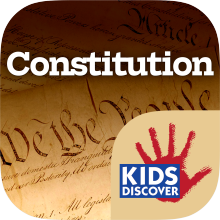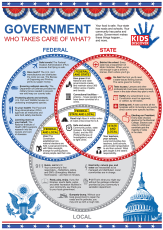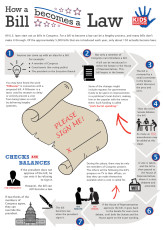With their serious black robes, the Supreme Court may look stern and even dull to some, but it is full of high drama. Some of the most historic moments in American history have taken place before the court. Every year, the court hears high-stakes cases on everything from the freedom of speech to the rights of people accused of crimes. Some decisions are unanimous. Others are squeakers, with the opinions of the justices very divided. But the goal of all the Supreme Court justices is the same: to uphold the laws and freedoms they have sworn to protect.
The nine justices on the Supreme Court all meet in Washington, D.C. They are part of the judicial branch of the government—our system of courts. Throughout the country, there are local courts, state courts, and federal courts. But the Supreme Court is the only court established and named in the U.S. Constitution. It is the highest court in the land—and sometimes called the “court of last resort.”
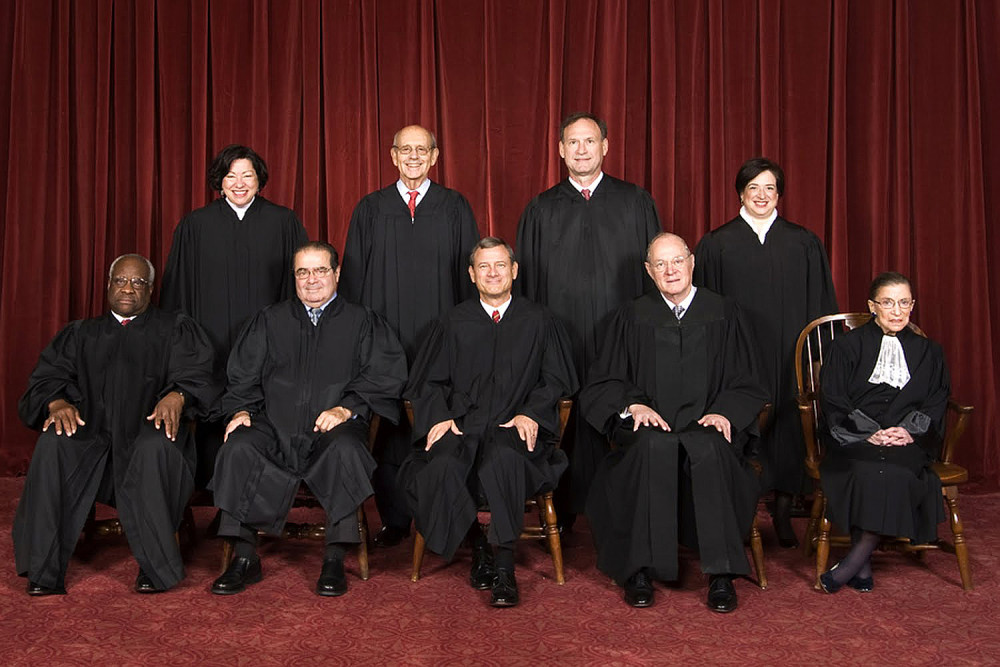
Meet the Supremes! From top left to right, Sonia Sotomayor, Stephen Breyer, Samuel Alito, and Elena Kagan. From bottom left to right, Clarence Thomas, Antonin Scalia, John Roberts, Anthony Kennedy, and Ruth Bader Ginsburg. John Roberts is the chief justice, and Elena Kagan is the “junior justice,” which means she is the justice most recently appointed to the court. (Photo Credit: Steve Petteway)
How do you get to be a justice on the Supreme Court? All of the justices are nominated by the president of the United States, and appointments must be confirmed by a majority vote in the U.S. Senate. Although there are no legal requirements for nominees, almost all candidates have been both lawyers and judges. Before being confirmed, the nominees answer questions from senators—and the questioning can go on for days. It’s a tough process, but most nominees get through it. (Out of 160 nominees in the nation’s history, only 12 have been rejected.)
Once confirmed, justices serve for the rest of their lives—or until they choose to retire. New members can only be appointed when one of the nine justices leaves. The longest time anyone served on the Supreme Court was 36 years, 7 months, and 8 days.
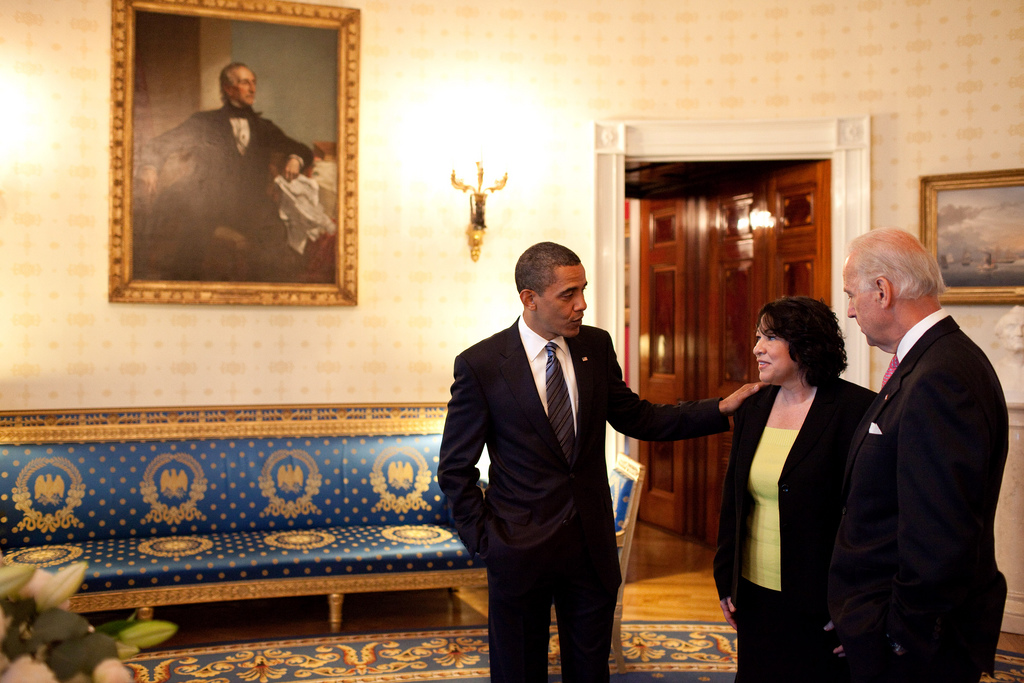
At the White House, President Barack Obama and Vice President Joe Biden congratulate Sonia Sotomayor after the president nominated her to serve on the Supreme Court. (Photo Credit: The White House)
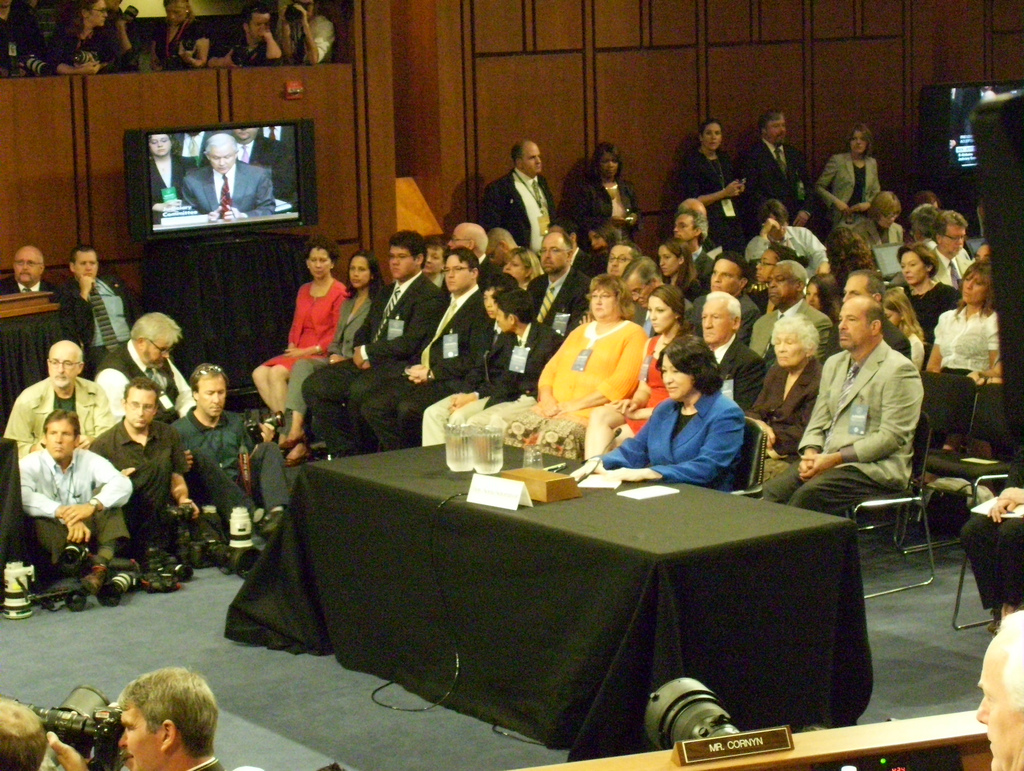
Before becoming a Supreme Court justice, Sonia Sotomayor had to answer questions posed by members of the Senate Judiciary Committee in front of journalists and a large audience. “The task of a judge is not to make law. It is to apply the law,” she said to the committee. She also thanked her mom who was sitting behind her. (Photo Credit: Talk Radio News Service)
Today, the Supreme Court has its own building, and each of the nine justices has offices and a staff of assistants. But the first time the Supreme Court met in 1790, the justices didn’t have a courtroom. They didn’t even have any cases. The United States was so young—it had won its independence from Britain only recently—it wasn’t clear how the court would work. But one thing got settled right away. Back in Britain, judges wore (and still often wear) white wigs. When one of the newly appointed justices to the first-ever U.S. Supreme Court showed up wearing a powdered wig in the British style, he was mocked on the street. He was the last Supreme Court justice to make that fashion mistake.
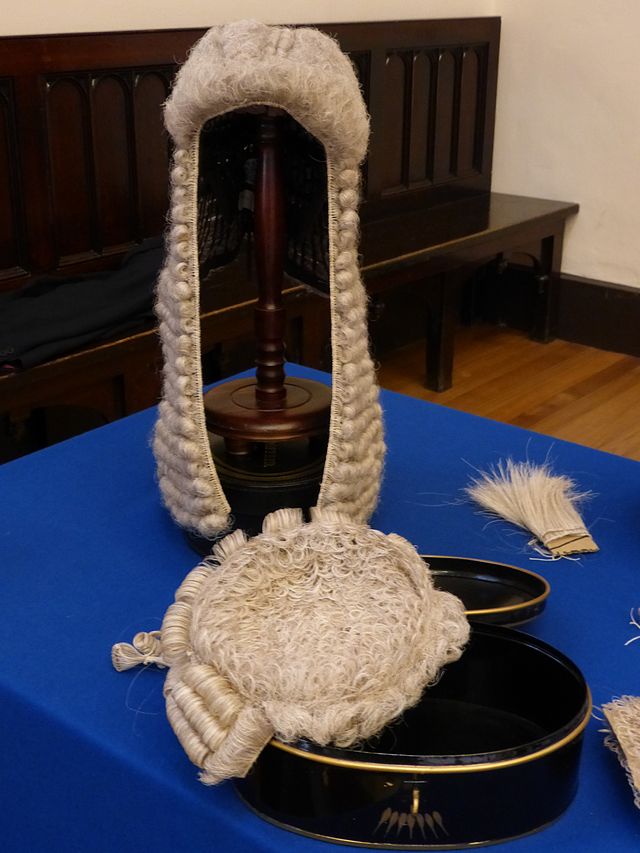
White powdered wigs (made of horsehair) were worn by judges and lawyers in British courts. But the U.S. Supreme Court did not adopt this style. In fact, Thomas Jefferson advised—not long after he wrote the Declaration of Independence—“for heaven’s sake, discard the monstrous wig.” (Photo Credit: Kim Traynor)
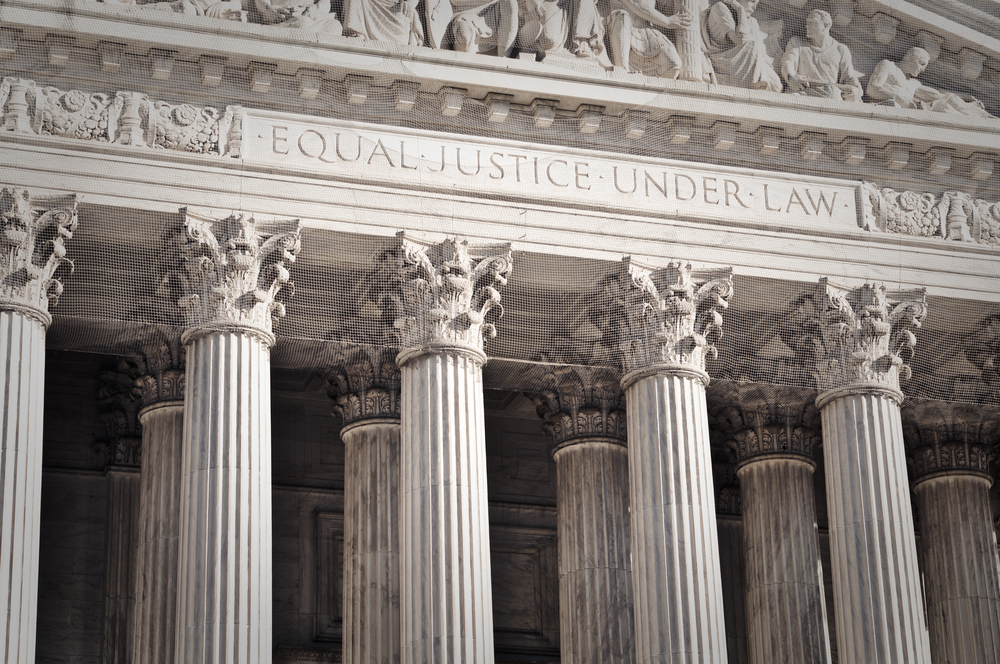
The Supreme Court Building in Washington, D.C., was built in 1935 in the style of an ancient Roman temple. The columns hold up the court’s motto, “Equal Justice Under Law.” (Shutterstock: Brandon Bourdages)
The only courtroom fashion that survived from the British tradition was the robe. In the earliest years of the Supreme Court, many of the justices wore red robes trimmed with black and silver. But one of the first chief justices, John Marshall, put an end to those colorful days. Marshall went with an all-black robe, and his fellow justices followed his lead. Ever since then, the justices have been known for their black gowns, which are meant to be symbols of equality and impartiality.
Before going to court, the justices meet in the Supreme Court “robing room.” There, each of the justices shakes hands with all the others. This hand-shaking ceremony helps remind them of their shared purpose of upholding the law, even if they sometimes disagree and have different opinions.
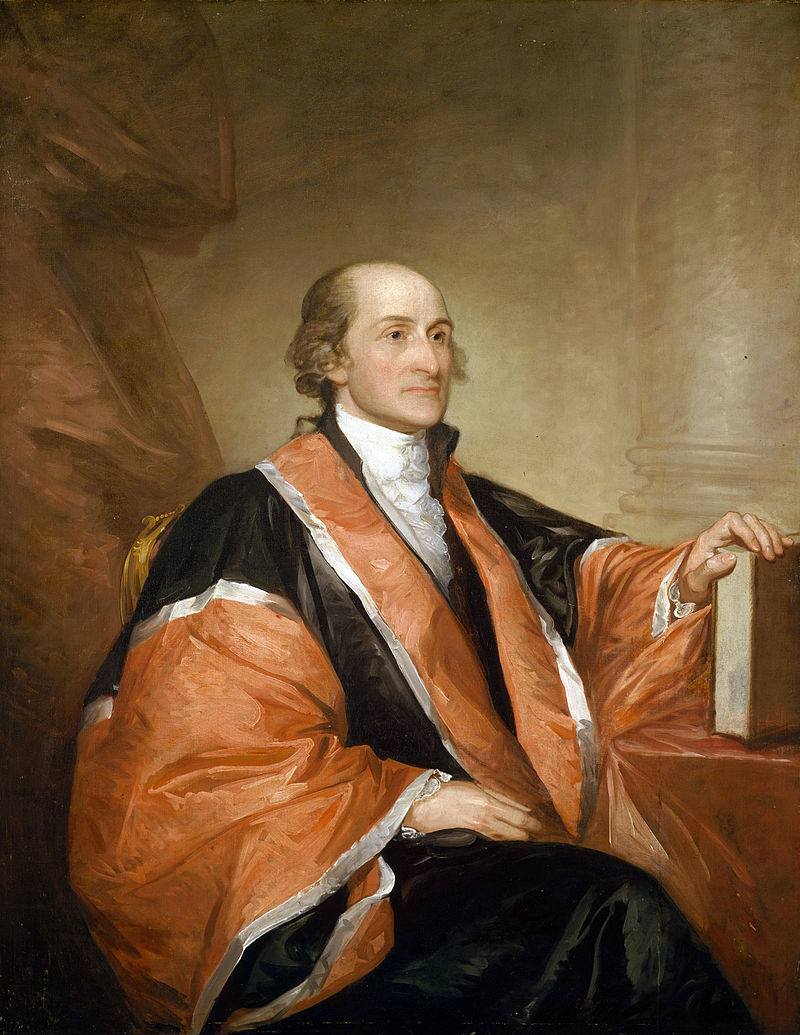
John Jay was the very first chief justice of the Supreme Court. In the early years of the court, multicolor robes were the fashion. (Portrait: Gilbert Stuart)
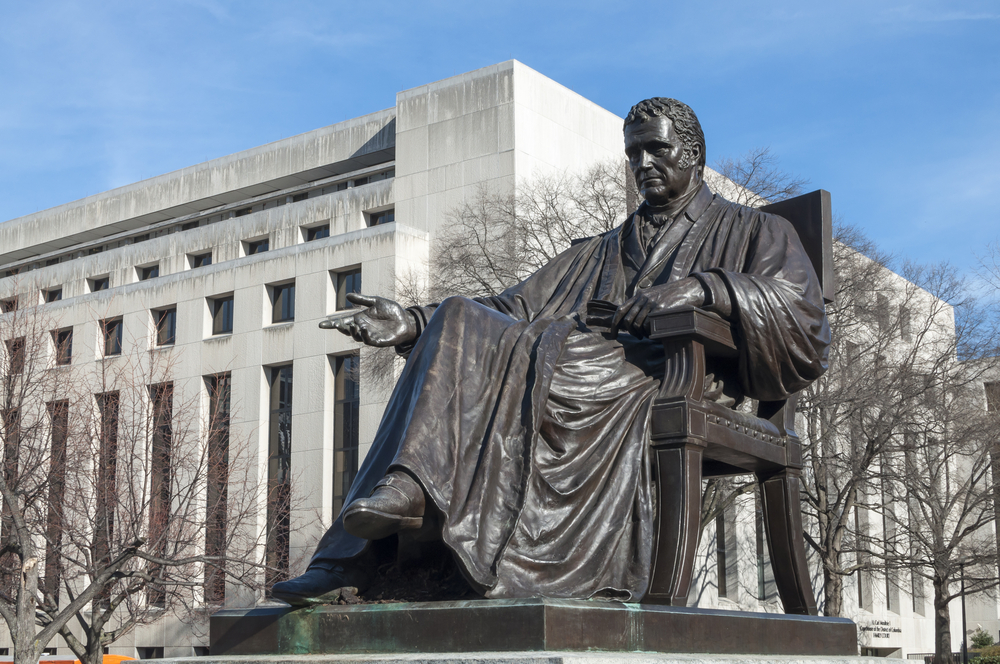
Chief Justice John Marshall served on the Supreme Court from 1801 to 1835. His helped make the judiciary the powerful branch of government that it is today. (Shutterstock: Chad Zuber)
John Marshall wasn’t only important because of his ice-cold sense of style. When he became chief justice in 1801, the Supreme Court still did not have a clear mission. The Marshall court changed all that with a case called Marbury v. Madison. (The “v” means versus.) This case was important because it was the first time the Supreme Court threw out a law because it was unconstitutional. Basically the Supreme Court declared it had the power to say FAIL to a law passed by Congress if it violated the Constitution.
In his decision on Marbury v. Madison, Chief Justice Marshall wrote that the Constitution is “the fundamental and paramount law of the nation.” It was the Supreme Court’s job, Marshall said, to rule against the president, the Congress, and even state governments if they took on powers beyond what was allowed in the Constitution. Marshall built up the powers of the judiciary so they were equal to the powers of the executive and legislative branches of government. To this day, this is a critical part of the U.S. government’s system of checks and balances.
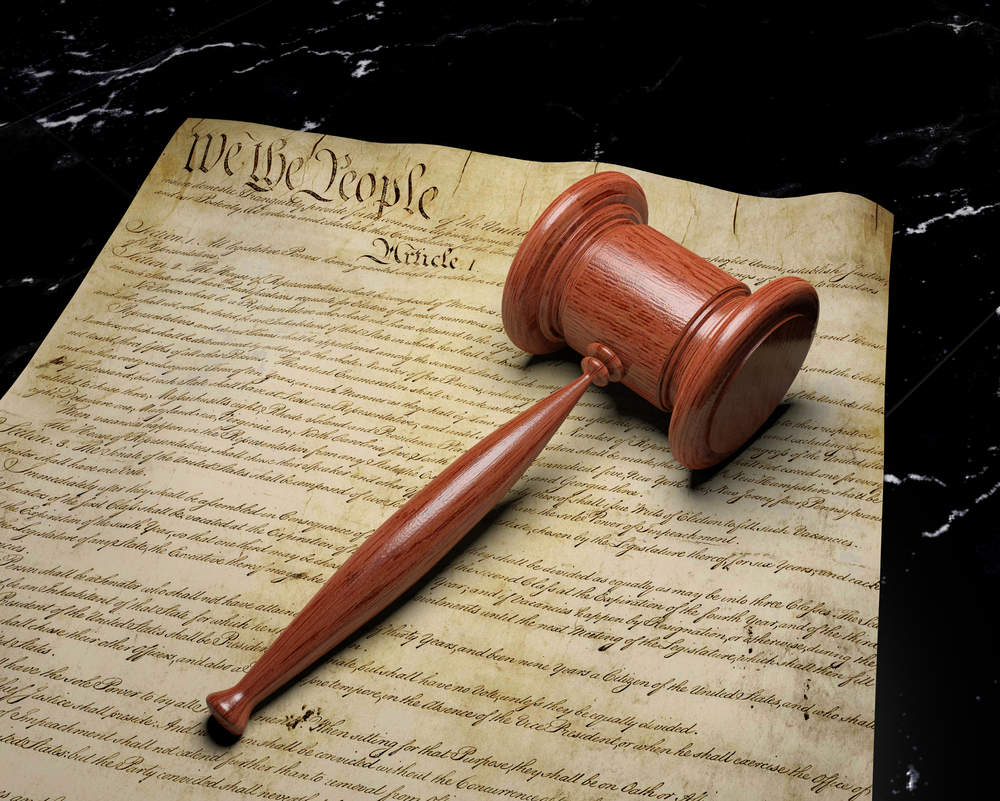
The United States is a nation of laws, and the Constitution is its founding document. The Constitution lays out America’s form of government and the rights of its citizens. Some of the rights in the Constitution include the freedom of speech and the right to equal protection under the law. The Supreme Court often hears cases on topics of constitutional law. (Shutterstock: artboySHF)
Sometimes you’ll hear someone say, “We’re going to take this all the way to the Supreme Court!” That usually means that person thinks a decision made by a lower court is unfair and unjust. A petitioner can ask a court that hears appeals (such as a federal circuit court or state appeals court) to overturn the ruling of a lower court. Then if the parties are still not happy with the outcome, they can appeal to higher courts—and ultimately to the Supreme Court. But—and this is a big BUT—less than one out of every ten cases appealed to the Supreme Court actually gets heard.
Why don’t all the cases get heard? First of all, the Supreme Court can only accept certain kinds of cases. Cases that come up through the lower courts have to have something to do with federal law or the Constitution. Otherwise they’re not in the Supreme Court’s jurisdiction. (In rare situations, the Supreme Court can also be the very first place a case is heard—such as when there is a dispute between two states.) Almost all the Supreme Court’s cases come from the lower courts and are heard on appeal.
Secondly, four out of the nine justices have to agree to even take a case. They only take cases that are considered very important, involving disputes that don’t have an easy answer and that there may be public disagreement about. Cases may raise questions such as: How much authority do the police have? What punishments are legal under the law? Are there any limits on freedom of speech? The Supreme Court hears about 75 cases each year.
If the Supreme Court agrees to hear a case, the lawyers for the petitioner write to the court with an argument about why they think the decision of the lower court was wrong. This is called writing a brief. The lawyers for the opposite side (the respondent) also write a brief stating their arguments. In highly important cases, people who are not directly involved with the case (but who have a strong opinion) are permitted to file briefs as “friends of the court.”
The Supreme Court isn’t like trial courts that have witnesses and juries. The briefs are read behind the scenes, and all the action in the courtroom takes place during oral arguments. The lawyers for the petitioner and respondent each have just 30 minutes to state their case. And guess what? The justices interrupt—a lot. Getting grilled by the justices is challenging to say the least. Their questions are tough. And they are not shy about cutting off lawyers in mid-sentence.
A few days after the oral arguments, the justices go into conference. The conferences are private—no one can go into the room, except the nine justices. The most recently appointed member of the court serves as the “doorkeeper,” receiving any papers from outside and carrying any messages. In the conference, the justices discuss, debate, and vote on the cases they have heard. Do the justices always agree? Definitely not. Majority rules on the Supreme Court—and some decisions are narrow with the judges voting 5-4.
When the justices have voted on a case, one of them is chosen to write the reasons behind their decision—this is called an “opinion.” If some of the justices disagree with the majority, they can write a “dissenting” opinion. Some opinions are very long. And sometimes they are very sharply worded. The ultimate decision is secret until the opinions are released at a public press conference.
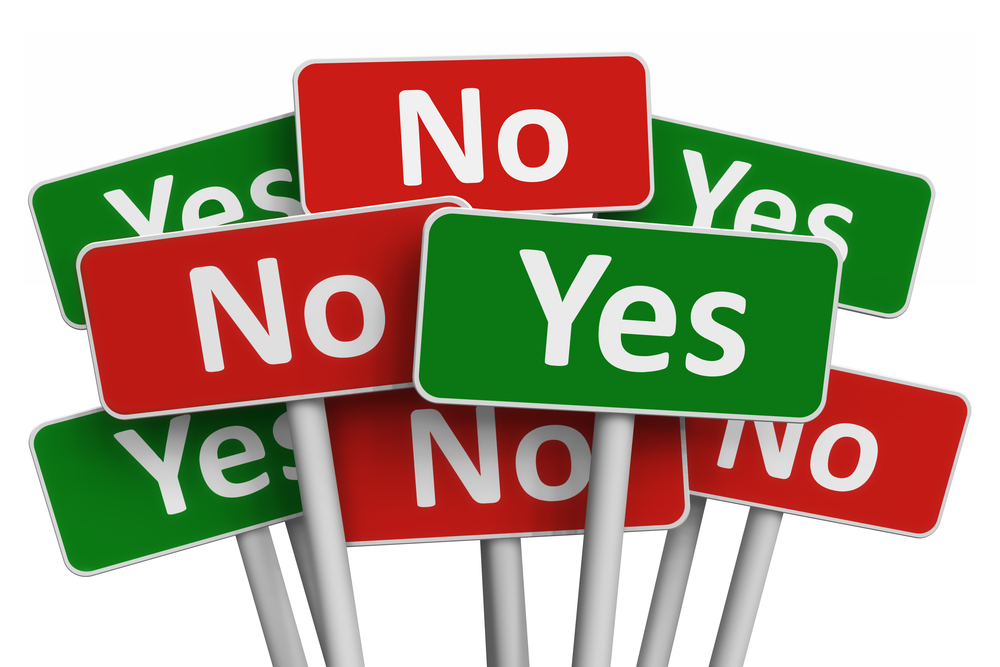
When the justices vote on a case in conference, the chief justice goes first and then the other justices state their votes by seniority, with the junior justice voting last. (Shutterstock: Oleksiy Mark)
Why don’t the justices always agree on cases? There can be different opinions about how laws should be interpreted and what the writers of the Constitution meant. For example, the Constitution includes the Bill of Rights and many amendments. The First Amendment says, “Congress shall make no law… abridging the freedom of speech.” Does that mean you can stand outside your home at 3 in the morning every night and scream whatever you want at the top of your lungs—even if you wake up all your neighbors? That’s probably not what the writers of the Constitution had in mind.
Here are two examples from opinions about freedom of speech, written by justices on the Supreme Court. They are carefully worded—and are food for thought about how the Supreme Court interprets the Constitution.
“If there is a bedrock principle underlying the First Amendment, it is that the government may not prohibit the expression of an idea simply because society finds the idea itself offensive or disagreeable.”—Supreme Court Justice William J. Brennan, Jr., Texas v. Johnson (1989)
“The most stringent protection of free speech would not protect a man in falsely shouting fire in a theater and causing a panic… The question in every case is whether the words used are used in such circumstances and are of such a nature as to create a clear and present danger that they will bring about the substantive evils that Congress has a right to prevent. ” –Justice Oliver Wendell Holmes, Schenk v. U.S. (1919)
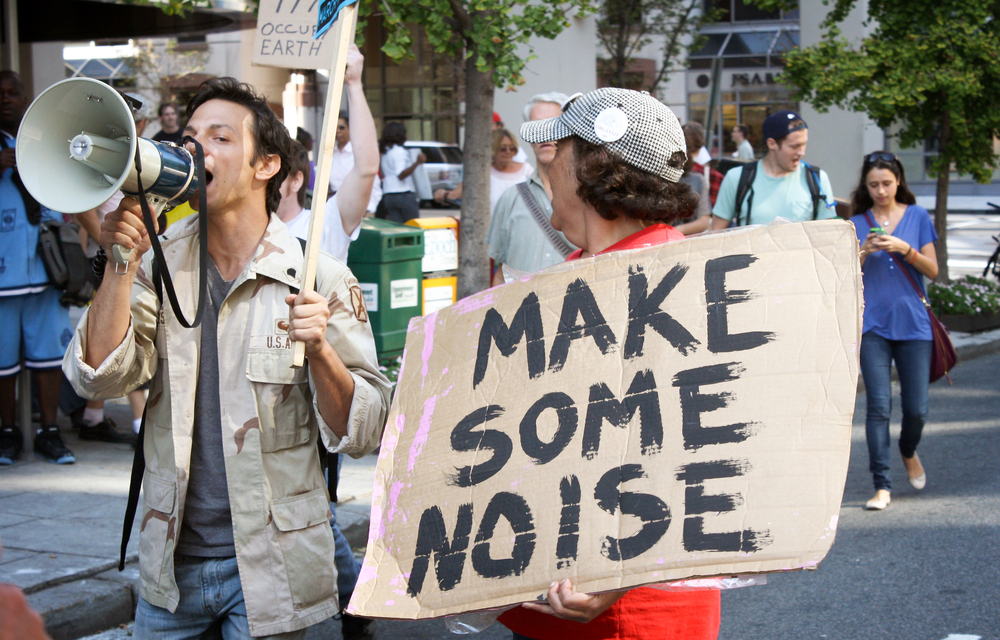
Protestors exercise their right to free speech as they march through Washington, D.C. (Shutterstock: Evan McCaffrey)
Supreme Court decisions can be historic and very influential. But even the decisions of the Supreme Court can be “overturned”—sometimes by a future court and sometimes by amendments to the Constitution.
For example, the Supreme Court’s ruling in the Dred Scott v. Sandford case is considered today to be the court’s worst decision ever. Dred Scott was born into slavery, and he began suing for his freedom in 1847, fighting for years in the lower courts. When his case finally reached the Supreme Court in 1857, the justices ruled he had no right to bring his case to the court because black people could not be U.S. citizens. The abolitionist Frederick Douglass called this decision an “open, glaring, and scandalous tissue of lies.” In 1868 after the nation had gone through the Civil War and slavery had been abolished, Congress passed the 14th Amendment to the Constitution, which clearly states that everyone born in the United States is a citizen of the United States. This overturned the Dred Scott decision.
Here are a few other major decisions made by the Supreme Court.
–In 1954, 17 states had laws requiring that blacks and whites attend different schools and 4 states had laws that permitted racial segregation. These laws were challenged by the Brown family in Topeka, Kansas, and the case went all the way to the Supreme Court. In Brown v. Board of Education, the Supreme Court ruled that “separate educational facilities are inherently unequal” and that racial segregation violated the 14th Amendment of the Constitution which provides citizens with equal protection under the law. Thurgood Marshall was the lawyer who represented the Brown family’s case, and he later became the first African-American justice on the Supreme Court.
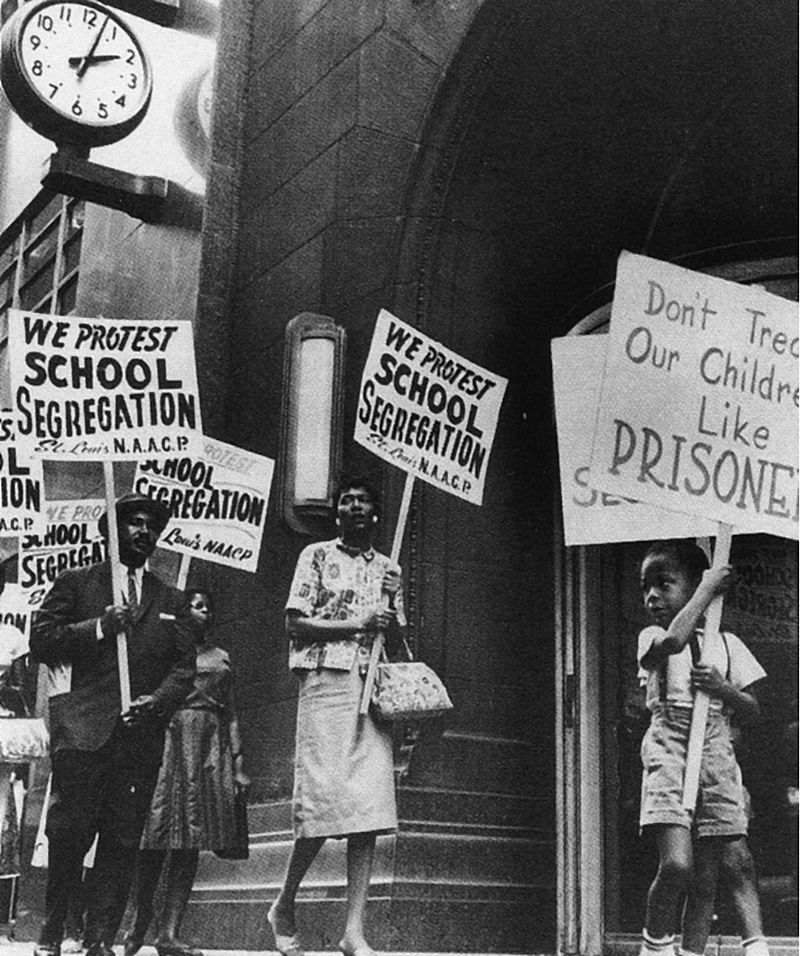
In the early 1950s, public protests helped bring the fight to desegregate schools all the way to the Supreme Court. (Photo Credit: Public Domain)
- A man named Clarence Gideon was charged with breaking and entering in Florida. Although he asked for a lawyer, he ended up having to defend himself in court. The Florida court found him guilty in 1961, and he got five years in prison. Gideon appealed his case all the way to the Supreme Court. In Gideon v. Wainwright, the court ruled in Gideon’s favor under the 6th and 14th Amendments to the Constitution and said that he had been denied a fair trial. Gideon got a new trial in Florida with a court-appointed lawyer—and the jury found him innocent. Ever since, all U.S. citizens charged with a crime must be provided a lawyer—even if they cannot afford one.
- In 1972, five burglars were arrested trying to hide an illegal listening device in the Democratic National Committee headquarters at the Watergate Hotel in Washington, D.C. An investigation revealed that the Watergate burglary had been masterminded by people working in the White House, and it was strongly suspected that the president, Richard Nixon, was involved. In a strange twist, it was learned that Nixon had been secretly recording all the conversations he had at the White House. Nixon was ordered by the courts to give the recordings to the special prosecutor who was investigating—because they were evidence that would reveal if the president and his aides were involved in the burglary. But Nixon argued that he didn’t have to turn over the tapes because he was the president—and as president he had special privileges, didn’t he? When the case of United States v. Nixon reached the Supreme Court, the justices said the rulings of the lower courts were correct. Even the president of the United States is not above the law. Nixon turned over the tapes, and he resigned two weeks later.
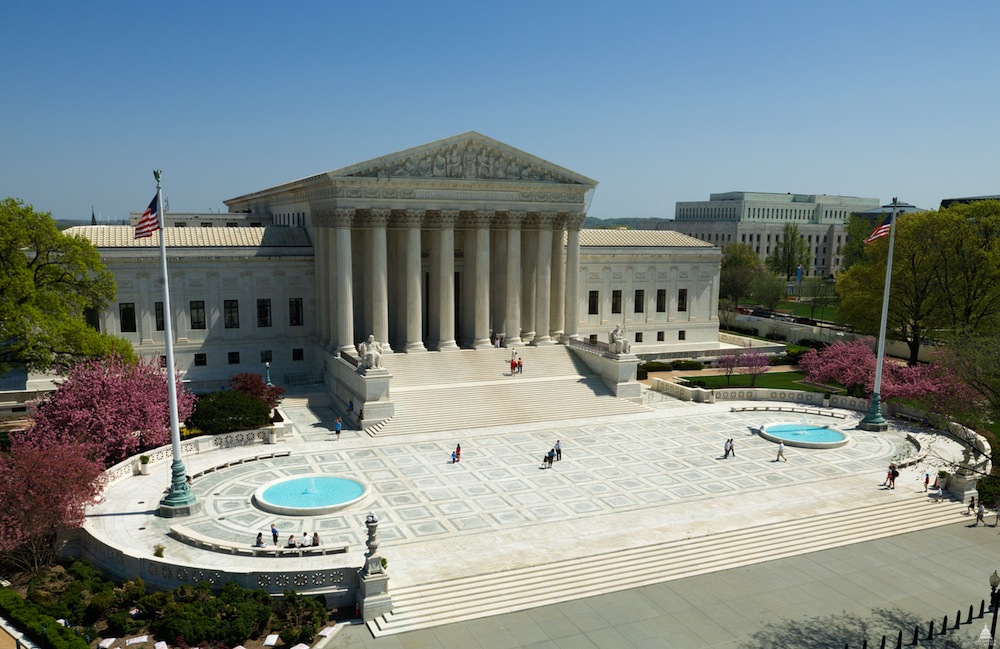
The Supreme Court building may look quiet, but what goes on inside can change the course of history! (Photo Credit: Architect of the Capitol)
Sometimes the court is deeply divided. The race for president in 2000 between George W. Bush and Al Gore was incredibly close. In the state of Florida, the vote was so close that an automatic recount of the votes was required. It turned out the whole election hinged on who won Florida. Out of nearly 6 million votes there, Bush was leading by about 1,700 votes. When all Florida’s ballots were recounted by vote-counting machines, Bush was still in the lead, but the election got even closer! Under Florida law, Gore and his lawyers had the right to ask that ballots be recounted by hand in counties where they believed mistakes had been made. BUT election officials only had a few days to do the “manual” recounts. It was a wild race to the finish, with election officials and local judges working late into the night and examining ballots with magnifying glasses.
In the courts of Florida, Gore and his lawyers asked that the counties be given more time to finish—and the highest court in Florida agreed. However, this case quickly went to the Supreme Court. In Bush v. Gore, five out of nine justices—a majority—overturned the Florida high court’s decision. Although a minority of justices strongly disagreed, the majority said the recount was unconstitutional because different counties were conducting the recount in different ways—and that meant voters were being treated unequally. With the recount stopped and Bush ahead by 537 votes, Bush was declared the new president—more than a month after the election!
President Bush went on to successfully nominate two justices to the Supreme Court, including John Roberts, who is now chief justice, and Samuel Alito.
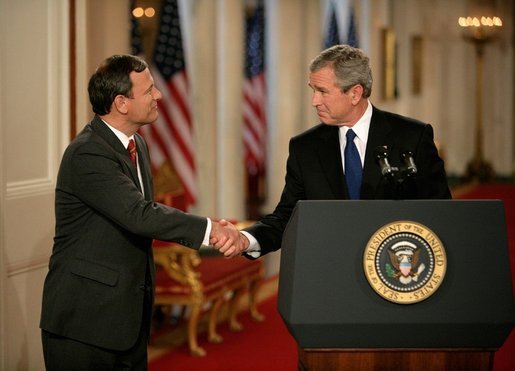
Bush congratulates John Roberts after nominating him to the Supreme Court. (Photo Credit: Public Domain)
Written by Margaret Middlebach
[wp-simple-survey-36]




